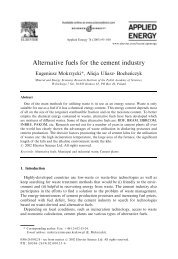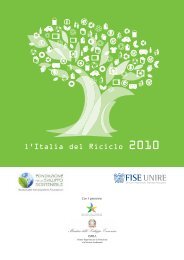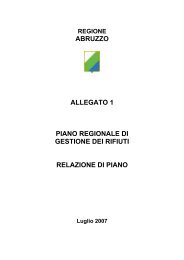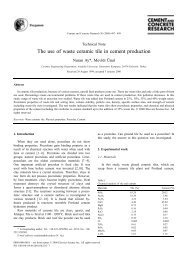GUIDELINES Disposal of Wastes in Cement Plants - BAFU
GUIDELINES Disposal of Wastes in Cement Plants - BAFU
GUIDELINES Disposal of Wastes in Cement Plants - BAFU
Create successful ePaper yourself
Turn your PDF publications into a flip-book with our unique Google optimized e-Paper software.
<strong>GUIDELINES</strong> <strong>Disposal</strong> <strong>of</strong> Waste <strong>in</strong> <strong>Cement</strong> <strong>Plants</strong> Appendix I, page 8/12<br />
Positive list / B) Raw materials Status: May 2007<br />
No.<br />
LMW Code Description <strong>of</strong> the<br />
waste<br />
Remarks / Requirements Supplement Guidance<br />
value 1)<br />
B5<br />
17 05 03 [S]<br />
17 05 05 [S]<br />
17 05 07 [S]<br />
17 05 93 [ ]<br />
17 05 94 [ ]<br />
17 05 95 [ ]<br />
17 05 96 [ak]<br />
19 13 01 [S]<br />
19 13 02 [ ]<br />
19 13 03 [S]<br />
19 13 04 [ ]<br />
Residue from soil<br />
clean<strong>in</strong>g facilities, soil,<br />
concrete and mixed<br />
demolition waste,<br />
ma<strong>in</strong>ly contam<strong>in</strong>ated<br />
with organic substances<br />
Residues from soil<br />
wash<strong>in</strong>g facilities, soil,<br />
concrete and mixed<br />
demolition waste,<br />
ma<strong>in</strong>ly contam<strong>in</strong>ated<br />
with organic compounds<br />
For these wastes, different regulations apply. We are deal<strong>in</strong>g here with residues from the<br />
remediation <strong>of</strong> contam<strong>in</strong>ated sites. The authority concerned must decide <strong>in</strong> each <strong>in</strong>dividual<br />
case whether disposal <strong>in</strong> a cement plant is permissible. In general, residues from soil wash<strong>in</strong>g<br />
and preparation facilities that are contam<strong>in</strong>ated with organic compounds may be disposed <strong>of</strong><br />
<strong>in</strong> cement plants if the organic components are completely combusted and the cement plant is<br />
equipped with a flue gas treatment system appropriate to handle organic substances (e.g.<br />
active carbon filters). The waste must comply with the requirements for alternative raw<br />
materials (pollutant concentrations <strong>in</strong> Table 1, column B), and the follow<strong>in</strong>g supplement<br />
applies:<br />
Exceptions to the guidance values <strong>in</strong> Table 1, column B, <strong>of</strong> the Guidel<strong>in</strong>es are specified<br />
<strong>in</strong> the supplement for a series <strong>of</strong> heavy metals. A maximum <strong>of</strong> four <strong>of</strong> these exceptions<br />
may be <strong>in</strong>voked <strong>in</strong> any <strong>in</strong>dividual case. Should the content <strong>of</strong> five or more heavy metals<br />
exceed the guidance values <strong>in</strong> Table 1, column B, then disposal <strong>in</strong> cement plants is not<br />
permissible.<br />
The same requirements also apply to contam<strong>in</strong>ated materials that for technical reasons<br />
cannot be recycled or whose recycl<strong>in</strong>g is not beneficial for environmental reasons (e.g.<br />
contam<strong>in</strong>ated concrete), and which are therefore dispatched to a cement plant with<br />
appropriate flue gas treatment. When contam<strong>in</strong>ated soil is to be disposed <strong>of</strong> <strong>in</strong> cement plants<br />
without prior preparation, its pollutant content must be expressed relative to the f<strong>in</strong>e particle<br />
fraction (particles less than 63 micrometer). Thus, for example, sandy soil with 50% f<strong>in</strong>e<br />
particle fraction and an effective chromium content <strong>of</strong> 90 mg/kg has a chromium content<br />
relative to the f<strong>in</strong>e particle fraction <strong>of</strong> 180 mg/kg (100/50 x 90). The pollutant content<br />
relative to the f<strong>in</strong>e particle fraction calculated <strong>in</strong> this way must fulfil the above regulations<br />
on pollutant content.<br />
Antimony<br />
Lead<br />
Cadmium<br />
Chromium<br />
Cobalt<br />
Copper<br />
Nickel<br />
Mercury<br />
Z<strong>in</strong>c<br />
T<strong>in</strong><br />
PCDD/PCDF<br />
PCB<br />
see page 4/6<br />
Sb<br />
Pb<br />
Cd<br />
Cr<br />
Co<br />
Cu<br />
Ni<br />
Hg<br />
Zn<br />
Sn<br />
20 mg/kg<br />
500 mg/kg<br />
5 mg/kg<br />
500 mg/kg<br />
100 mg/kg<br />
500 mg/kg<br />
500 mg/kg<br />
2 mg/kg<br />
1.500 mg/kg<br />
100 mg/kg<br />
10 mg TEQ/kg<br />
50 mg/kg<br />
1): Def<strong>in</strong>ition accord<strong>in</strong>g to the Methodology paper; exceptions with regard to Table I <strong>of</strong> the Guidel<strong>in</strong>es








